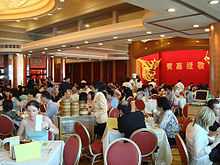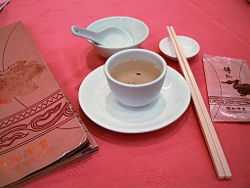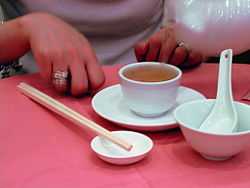Yum cha
| Yum cha | |||||||||||||||||||||
 Yum cha hour in Hong Kong | |||||||||||||||||||||
| Traditional Chinese | 飲茶 | ||||||||||||||||||||
|---|---|---|---|---|---|---|---|---|---|---|---|---|---|---|---|---|---|---|---|---|---|
| Simplified Chinese | 饮茶 | ||||||||||||||||||||
| Literal meaning | drink tea | ||||||||||||||||||||
| |||||||||||||||||||||
Yum cha (simplified Chinese: 饮茶; traditional Chinese: 飲茶), also known as ban ming (品茗), is a southern Chinese style morning or afternoon tea, which involves drinking Chinese tea and eating dim sum small dishes (steamed, fried or baked sweets). There are various ways in which the food can be served. In highly patronized restaurants, staff will commonly wheel around heated trolleys serving small yum cha dishes that have been prepared in advance in the kitchen; this manner allows customers receive hot, fresh items quickly. In less busier places, ordering dim sum will typically involve marking an order sheet with the desired quantity of items to be ordered; this practice eliminates unnecessary preparation of dishes which may otherwise not be ordered.
Terminology
Yum cha in Cantonese Chinese literally means "drink tea", while ban ming is a more poetic term meaning "tasting of tea". In the US and UK, the phrase dim sum is often used in place of yum cha; in Cantonese, dim sum (點心) refers to the wide range of small dishes, whereas yum cha, or "drinking tea", refers to the entire meal. Cantonese-speaking communities in Canada, however, still tend to use the phrase "yum cha".
Prevalence
The Cantonese Chinese term yam cha or yum cha primarily refers to the tradition of morning tea in Cantonese cuisine exemplified by the traditional tea houses of Guangzhou (Canton). Due to the prevalence of Cantonese cuisine outside China, the Cantonese yum cha tradition can be found in many parts of the world. By analogy, yum cha is also used to refer to morning or afternoon teas in other Chinese cultural traditions, even though such meals have different native names.
Dim sum
Similarly to a Western morning or afternoon tea, despite the name, yum cha is focused as much on the food items served with the tea as the tea itself. These food items are collectively known as "dim sum", a varied range of small dishes which may constitute or replace breakfast, brunch or afternoon tea. Dishes are usually steamed or fried and may be savoury or sweet. They include steamed buns such as char siu baau, assorted dumplings, siu mai, and rice noodle rolls, which contain a range of ingredients, including beef, chicken, pork, prawns and vegetarian options. Typical desserts include egg tarts, sai mai lo (tapioca pudding) and mango pudding. Many yum cha restaurants also offer plates of steamed green vegetables, roasted meats, congee porridge, and soups.
Dim sum can be cooked by steaming and frying, among other methods. The dim sums are usually small and normally served as three or four pieces in one dish. It is customary to share dishes among all diners on the same table. Because of the small portions people can try a wide variety of food.
Traditionally, the cost of the meal was calculated based on the number and size of dishes left on the patron's table at the end. In modern yum cha restaurants, dim sum servers sometimes mark orders by stamping a card on the table. Servers in some restaurants even use different stamps so that sales statistics for each server can be recorded.
Eating utensils

Methods of tea-tasting have undergone considerable changes since the Tang Dynasty and the use of covered teabowls is one development of note. The simple yet practical design of covered teabowls makes them an excellent utensil for tea-tasting. The fine painting on these bowls also enhances their aesthetic value. Nowadays a small teacup is used instead in most dim sum restaurants.
Chopsticks, a pair of small even-length tapered sticks, are the traditional eating utensils used for yum cha. Chopsticks are commonly made of plastic in the Chinese restaurants. Held between the thumb and fingers of the working hand they are used as tongs to pick up portions of food or to sweep rice and small particles of food into the mouth from the bowl. Dim sum dishes are served in small portions and therefore convenient for eating with chopsticks. Many rules of etiquette govern the proper use of the chopsticks.
Toothpicks are frequently used between courses, as it is believed that the aftertaste of one course should not be allowed to ruin one's enjoyment of the next course. Toothpicks are ideal and socially acceptable for picking up those meal items which often defy the best chopstick approach, such as slippery button mushrooms and jellyfish slices served with sesame oil.
Customs and etiquette


It is customary to pour tea for others before filling one's own tea cup. It is most gracious to be the first to pour tea.
When tea drinkers tap the table with two (occasionally one) fingers of the same hand, an action known as 'finger kowtow', it means thanks. According to a just-so story, this gesture recreates a tale of Imperial obeisance and can be traced to Emperor Qianlong, a Qing Chinese emperor, who used to travel incognito. While visiting South China, he once went into a teahouse with his companions. In order to maintain his anonymity, he took his turn at pouring tea. His stunned companions wanted to kowtow for the great honour but to do so would have revealed the identity of the emperor. Finally, one of them tapped three fingers on the table (one finger representing their bowed head and the other two representing their prostrate arms) and the clever emperor understood what he meant. From then on, this has been the practice.
See also
References
- Everything You Want to Know about Chinese Cooking by Pearl Kong Chen, Tien Chi Chen, and Rose Tseng. Woodbury, New York: Barron's, 1983.
- How to Cook and Eat in Chinese by Buwei Yang Chao. New York: The John Day Company, 1945.
- Dim Sum: The Delicious Secrets of Home-Cooked Chinese Tea Lunch by Rhoda Yee. San Francisco: Taylor & Ng, 1977.
- Classic Deem Sum by Henry Chan, Yukiko, and Bob Haydock. New York: Holt, Rinehart, and Winston, 1985.
- Chinese Dessert, Dim Sum and Snack Cookbook edited by Wonona Chong. New York: Sterling, 1986.
- Tiny Delights: Companion to the TV series by Elizabeth Chong. Melbourne: Forte Communications, 2002.
| ||||||||||||||||||||||||||||||||||
| ||||||||||||||||||
